The Future of Wastewater Treatment Plant Energy Management
About the author:
Hans Ruijgers is the head of communications and the press officer for KWR Water Research Institute. Ruijgers can be reached at [email protected].
The future of wastewater treatment involves bubbles, just less of them, according to Peter Vale.
As the technical lead for innovation at UK utility, Severn Trent (ST), he has spent much of his career looking at extending the traditional technique of activated sludge that involves a lot of bubbles.
“Despite its widespread adoption, you can't get away from the fact that is it energy-intensive,” he said, despite praising the technology‘s flexibility.
He said he believes there is potential for a step-change in wastewater treatment. Eventually, the process will become carbon negative, energy positive and will maximize the recovery of nutrients.
And there is one particular innovation site outside Redditch, a UK town close to the city of Birmingham, that is proving this could happen sooner rather than later. Developments at the Spernal wastewater treatment plant (WWTP) are part of Severn Trent’s “Triple Carbon Pledge”, to meet net zero emissions, generate 100% energy from renewable sources and operate a 100% electric fleet by 2030.
This is part of a much broader and equally ambitious country-wide pledge from English water companies to reach net zero carbon emission levels by 2030.
“Net zero emissions by 2030 and the transition to a circular approach to sewage treatment requires technology innovation,” Vale said. “Spernal has become a testbed that allows us to evaluate and validate the range of innovative technologies and processes we need to deliver on this commitment.”
Who needs bubbles?
It is estimated that 22,000 wastewater treatment plants across Europe consume more than 1% of the EU’s overall electricity consumption.
While 1% may not sound a lot, it is a vast energy footprint not to mention cost for utilities. To put this into a local perspective, Severn Trent spends an average of £15 million per year on energy to run its activated sludge plants (the treatment process employed on the larger treatment works), “just blowing bubbles into concrete tanks full of sewage,” Vale said.
Yet times are changing, with Vale continuously asking the same big question regularly.
“Can we build a sewage treatment flowsheet that gives us a truly energy-positive WWTP?” he asked. “What we'd love to be able to do is switch from energy-intensive aerobic treatment to energy neutral, potentially even energy positive, anaerobic treatment.”
Europe’s largest AnMBR
One notable development is what is being labelled “Europe's largest” Anaerobic MBR, (AnMBR), process. Historically used in warmer climates, such as Brazil, anaerobic treatment has been successfully implemented to treat the wastewater from millions.
Severn Trent has been working with partners Cranfield University to see how anaerobic treatment works in more variable climates.
“It makes no sense at all, in terms of an energy balance, if you start heating the wastewater,” he says. “We are focused on making the process viable for much colder temperatures with weaker wastewater, rather than sludge.”
The key is the addition of the membrane, which Vale says helps to intensify the process and make it work in colder environments. The process allows nutrients to be recovered from the AnMBR effluent that can be used to make high-value fertilizer products.
Furthermore, the ammonia can be used as an “energy store”, either directly used as a fuel or by converting it to hydrogen. It may even be possible to produce added-value products such as protein, according to the technical lead.
Farmer partnerships are key
Generating additional valuable nutrients from wastewater streams is one thing, selling them to the market on a large scale is another. Thankfully Severn Trent has this covered, at least locally.
A dedicated farm liaison team communicates with the region’s well-developed agricultural community. With digested sludge (biosolids), already recycled to land, farmers are also kept up to date on the latest innovations in Severn Trent.
“It’s the end users, the farmers and the regulators that need to be brought into these circular economy conversations from the start,” added Vale. “We’re trying to find out what do the farmers want, rather than what can we produce. There is certainly recognition from the local farmers that they need to adopt a lower carbon footprint, and some of these new resources can help with that.”
Creating regional resource hubs
The Spernal demonstration site is part of the Horizon2020 (H2020) NextGen collaboration that aims to drive the circular economy through a wide range of water-embedded resources, including water, energy and materials.
The four-year H2020 project brings together a partnership of 30 organizations to demonstrate technological, business and governance solutions for water in the circular economy.
From water utilities to a beer brewery, 10 NextGen project in total have been selected to represent a variety of stakeholders who could participate and benefit from circular economy activities.
Christos Makropoulos is a professor at the National Technical University of Athens and a principal scientist at KWR, the coordinating organisation behind NextGen. He is also involved in other H2020 projects, including ULTIMATE, B-Watersmart and Water Mining.
Makropoulos said the potential exists to turn wastewater plants, such as Spernal, into regional “resource hubs,” albeit with some hurdles.
“We have the technology available to create regional resource hubs but regulatory and governance challenges remain because we have to connect multiple industries and stakeholders,” he said.
For this to be successful, Makropoulos said regional networks will need to be established that will mean “rethinking supply chains moving forward”.
He added that while it is unrealistic to think this can be achieved on a broader scale by 2030, he believes there could be multiple pilot regions in place across Europe.
“I would be very happy if, by 2030, there was one of these pilot regions in each member state,” he said. “This would mean a state-of-the-art treatment plant, with a new vision and business models in place, all underpinned by digital technologies and data.”
Operating 1000 wastewater treatment plants serving over four million people, Severn Trent has a huge asset base to operate and maintain. Clearly, the journey to carbon neutrality and energy positivity will happen gradually, one step and one plant at a time.



